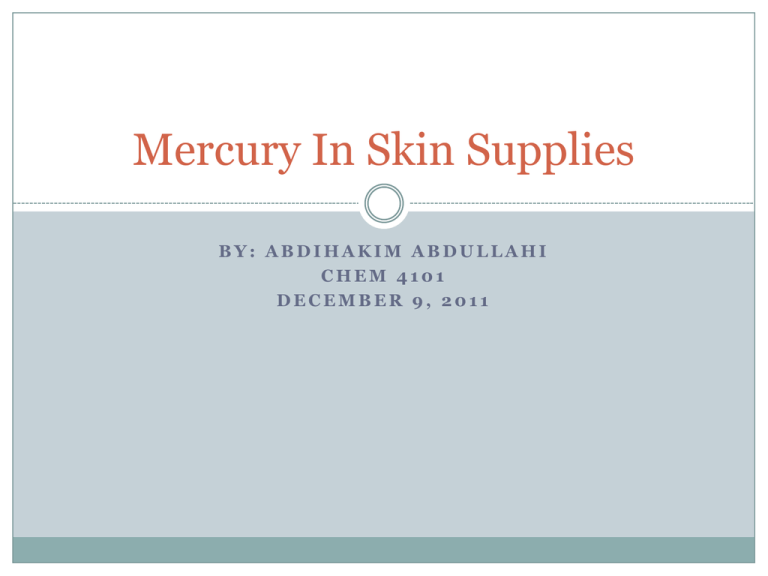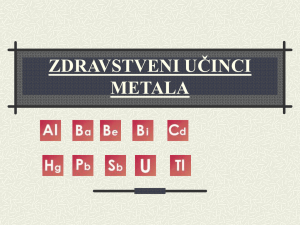AnalyticalPresentation1
advertisement

Mercury In Skin Supplies BY: ABDIHAKIM ABDULLAHI CHEM 4101 DECEMBER 9, 2011 Background Mercury in bleaching and cosmetic creams were introduced in the early 1900 when it was discovered that Mercury was extremely effective in lightening dark spots and stubborn pigmentation but it also had a high remission rate. Nevertheless bleaching creams with high levels of Mercury was aggressively marketed to black people. In 1976 Mercury was banned in the EU when it was discovered that it had damaging side effects. The US banned the use of Mercury in cosmetic creams much later in 1990. Mercury was banned as it proved to be very toxic and could absorb readily through the skin causing neurological effects. Problem: Recently more and more products such as Diana and Lemon Herbal Whitening Cream have shown up in the markets, through informal trade, with mercury levels well over the permitted federal limits, of less then one parts per million, of mercury. Some of these products have shown levels at 33,000 parts per million of mercury. Hypothesis: Mercury in said products cause a lot of health issues especially pertaining to communities in which these products keep showing up in. Experiment Overview Separation: My analyte, inorganic mercury, is in a very complex matrix (cosmetic cream) so the first thing we have to do is separate the mercury. Identify: Next we have to identify the mercury, then quantify it. A bottle of mercuric chloride which was classified as a poison.6 Possible Detector techniques Technique Advantages Disadvantages UV-Vis Absorption Simple design, quick sample analyses and it is nondestructive to sample. Requires frequent calibration, stray light can alter results. Atomic Absorption Spectroscopy Simultaneous analyses of different elemental species can be done. It can be used for trace analysis. Fast. A large number of interferences are possible, such as the formation of non-volatile compounds, smoke formation which will absorb light, contamination etc. Fluorescence Highly sensitive and thus can detect low quantities of the compound in question. It requires expensive and somewhat sophisticated equipment. Fluorescence Preferred Detection Method Advantages of Fluorescence: Highly sensitive technique Up to 1,000 times more sensitive than UV / visible spectroscopy. Therefore often used in drug or drug metabolite determinations by HPLC with fluorimetricdetector. Selective versatile technique Since excitation and emission wavelengths are utilised, gives selectivity to an assay compared to UV / visible spectroscopy. Possible Separation Methods Technique Advantages Disadvantages HPLC High Performance Liquid Chromatography GC Gas Chromatography CZE Capillary Zone Chromatography Speed (minutes), High resolution, Sensitivity (ng to fg), Reproducibility of +/- 1%, Accuracy, Automation Cost, Complexity, Low sensitivity for some compounds, Irreversibly adsorbed compounds not detected, Co-elution difficult to detect Highly accurate and fast Expensive and complex instrument, easy to overload phase, careful attention required rapid separation speeds, high efficiency, very small amount of sample is required Fairly new technique, still developing Separation Method of Choice Reverse phase HPLC coupled to a Hg-specific detector (fluorescence, photometry or other elemental detectors). Using an eluent of methanol-10 mM sodium acetate buffer (80:20, pH 6.2) containing 0.1 mM 2mercaptobenzothiazole (MBT). C18 column, UV detection at 285 nm. Detection limit for Hg is 0.5 ng Gemini 5µm C18 110A HPLC Mercury Cartridge 10 x 2.0 mm 10/Pk8 HPLC Schematic9 Conclusion By using analytical methods the mercury in these creams can be quantified then we can find out how toxic/dangerous these creams really are in hopes of finding a correlation to certain health disorders in communities in which these creams are sold. For my analyses HPLC coupled with a fluorescence detector would yield the best separations due to its high specificity, sensitivity, rapid sample analyses and sufficient detection limit for this problem. References 1. 2. 3. 4. 5. 6. 7. 8. 9. 10. 11. 12. 13. 14. Skin-Lightening Products Found to Contain Mercury: Minnesota Department of Health. http://www.health.state.mn.us/topics/skin/ (accessed September 19, 2011) Lide, D. R., ed (2005). CRC Handbook of Chemistry and Physics (86th ed.). Boca Raton (FL): CRC Press. pp. 4.1254.126. ISBN 0-8493-0486-5 Yao-Chin Wang, Chen-Wen Whang: High-performance liquid chromatography of inorganic mercury and organomercury with 2-mercaptobenzothiazole. Department of Chemistry, Tunghai University, Taichung 40704 Taiwan. http://www.sciencedirect.com/science/article/pii/002196739380340E (accessed online, November 7, 2011) Skoog , D, et al. Principles of Instrumental Analysis, 6th ed.; Brooks/Cole: Belmont, CA, 2007. Mercury Analysis in Environmental Samples by Cold Vapor Techniques. In: Encyclopedia of Analytical Chemistry. 2006. Mercury in skin-lightening creams: http://www.startribune.com/lifestyle/wellness/122598954.html Wells, A.F. (1984) Structural Inorganic Chemistry, Oxford: Clarendon Press. ISBN 0-19-855370-6. http://www.shimadzu.eu/products/chromato/hplc/modular/default.aspx http://www.chemistry.adelaide.edu.au/external/soc-rel/content/hplc.htm ATSDR, Toxicological Profile for Mercury, U.S. Department of Health and Human Services, Atlanta, GA, 1999.; (b) ATSDR, ToxProfiles: Mercury, U.S. Department of Health and Human Services, Atlanta, GA, 2005. H. Emeteborg, N. Hadgu, D. Baxter, Journal of Analytical Atomic Spectrometry 9, (1994), 297-302. High-Performance Liquid Chromatography (HPLC): www.files.chem.vt.edu/ chem-ed/sep/lc/hplc.html Yong-Suk Cho, Kyo Han Ahn, "A ‘turn-on’ fluorescent probe that selectively responds to inorganic mercury species" (Department of Chemistry and Center for Electro-Photo Behaviors in Advance Molecular Systems, POSTECH, San 31 Hyoja-dong, Pohang 790-784, Republic of Korea) http://www.postech.ac.kr/lab/chem/mras/download/90.pdf (Accessed online October 17th, 2011) Fluorescence Spectroscopy: chemistry.technion.ac.il/download.php?id=119&tbl=equations








